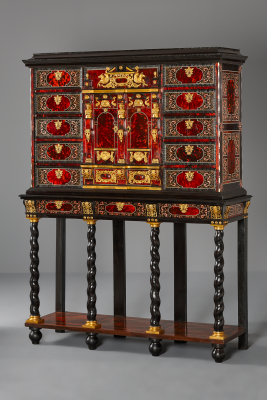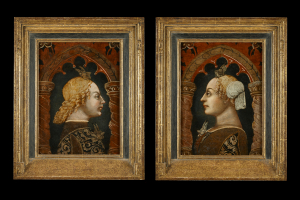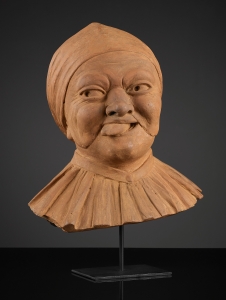Flemish Lacquer inlaid and Tortoiseshell Cabinet-on-stand, Antwerp
Flemish Lacquer inlaid and Tortoiseshell Cabinet-on-stand, Antwerp
In the Southern Netherlands of the seventeenth century both the Fine Arts and the Decorative Arts blossomed. With well-established ports in the cities of Antwerp, Bruges and Ghent, the Low Counties became the most important transit region in Europe for the export of local works of art and artisan products and the import of luxury products and valuables. Especially desirable were the highly ornamental lacquer boxes and cabinets imported from the Orient, richly inlaid with rare woods and intricate mother-of-pearl motives1. As the demand for these sumptuous items increased, Flemish craftsmen – especially in the city of Antwerp – mastered the skills and techniques of lacquer work and created their own tradition, resulting in a unique form of Flemish lacquer Art. These artist didn't merely imitate the Oriental lacquer decoration, but designed a particular and unequalled lacquer style, of which the present cabinet-on-stand is a fine and rare example.
Description
Preserved in an exceptional condition, this extraordinary and important cabinet-on-stand is veneered with ebony, tortoiseshell and inlaid lacquer, over a core and interior framework constructed out of oak and soft wood. The cabinet is placed on its original stand, made out of ebony veneered wood, tortoiseshell and lacquer. Both the cabinet and the stand are ornamented with polychrome lacquer composite known as laque incrusté, or as lacquer marquetry. In this typically Flemish type of ornamentation, tortoiseshell veneered cabinets are highlighted with a particular type of lacquer decoration, modelled after the above mentioned Oriental lacquer work, but also inspired by the Italian scagliola art2. The laque incrusté technique consists of applying a coloured substance of lacquer made out of a blend of bees' wax, shellac or other various colouring agents3 and tiny fragments of marble and mother-of-pearl4. When polished, the surface with its scattered chips of marble and mother-of-pearl imitates namban lacquer5, which was made in Japan for the export market.
The tortoiseshell veneers6 applied in the present cabinet are set over a red composition, with ivory and ebony stringing. The cabinet is applied with its original mouldings of refined gilded brass and strips of gilded copper. The rectangular upper-body of the cabinet incorporates two banks of five drawers to each side of an architectural aedicule7. The corpus of each drawer is constructed out of peltogyne wood, also known as amaranth. The drawer fronts are framed within an ebony ripple moulding and veneered with a tortoiseshell oval set against a red ground in its centre, flanked by lacquer decorations with scrolls of coloured marble composite and chips of mother-of-pearl. The centre of each drawer front is applied with a gilded brass ornamented lock plate. The shrine-shaped aedicule consists of two double doors and incorporates an upper- and a lower drawer, concealed by an overall architectural design. The upper drawer features a fronton8, with in its centre an oval panel placed in a gilded brass cartouche with guirlandes at both sides, crowned by a broken tympanum or pediment9, flanked at eacht side by a gilded brass prancing Pegasus10. The doors are decorated with half-round pediments, each applied with a brass shell-shaped ornament, over an oval cartouche, flanked by two brass dolphins. Under the arch-shaped pattern of inlaid ivory, a large brass shall-ornament with symmetrical guirlandes is placed. In the middle and on either side of the doors stand impressive caryatides11 representing Atlantid hemi-figures of Tritons12, placed on square-cut baluster-shaped columns, embossed with gilded brass ornaments. On the lower register, these columns continue into three scrolling volutes-shaped consoles, the middle one containing the lock of the hidden drawer. In between the consoles two oval tortoiseshell high-relief cabochons are set in a rectangular gilded brass cartouche of scrolling foliage. The whole of the exterior of the upper-body is veneered in ebony and in tortoiseshell set against red composition, with mounts of gilded brass. Interestingly, the ornaments applied on the aedicule, featuring Pegasuses, shell-shaped ornaments, dolphins and Tritons, all fit within the same nautical narrative and even the employed materials such as tortoiseshell and mother-of-pearl could be associated with this specific theme13.
The double doors of the aedicule open on gilded parliament hinges14 to reveal the so-called ‘perspective’, in contemporary sources referred to as ‘prospectiefke’15: a mirrored architectural interior with chequered floor, created to suggest the illusion of space. The inside of the each door is veneered with two square panels, displaying a rectangular geometric pattern in ebony and rosewood. This double-arched theatrical interior is flanked by two tortoiseshell veneered Corinthian pillars, adorned with elaborate gilded brass capitals, decorated with acanthus leaves and scrolls. In between the two pillars, a small inner drawer with ripple moulding – decorated in a similar manner to the outer drawers, yet inlaid with two octagon tortoiseshell plaques – forms the base of the floor of the ‘perspective’. Its arched mirror panels, which follow a relatively complex multi-faceted design allowing various viewpoints simultaneously16, are separated by gilded wooden columns.
The sides of the cabinet are veneered with two panels of square-shaped ornaments, against an ebony-veneered ground. Each square centres a vertically extended octagonal panel of red-backed tortoiseshell, outlined with ivory stringing and surrounded by four panels of laque incrusté scattered with chips of mother-of-pearl and multi-coloured marble. These spandrels are inlaid with composite of patterns of scrolling foliage and volutes, with four ornaments in the outer corners and two in the middle, in between the panels.
The lower-body of the piece is formed by its original stand, consisting of a frieze raised on eight leggs, and constructed out of ebony, oak and soft wood, with decorative veneers of tortoiseshell, ebony veneer and lacquer inlay. The upper-part of the stand consists of a frieze containing three drawers – which are decorated with the same ebony ripple moulding and veneer of tortoiseshell set against a red ground in its centre, flanked by lacquer decorations with with same patters as on the upper-body – separated by four volute-shaped consoles, applied with gilded brass mountings to the front, with two corresponding consoles at both sides, with two lacquer and tortoiseshell panels in between. The frieze is supported by eight legs, with four twisted legs standing on baluster feet in the front and four rectangular at the back. The four legs in the front – set off with a gilded brass cylinder mounting at the top and ending in a similar gilded brass base – follow the design of the so-called Solomonic column17, characterized by a spiralling twisting shaft. The legs are joined together by a horizontal sheet, applied with panels of marquetry in geometrical patterns.
The average Antwerp lacquer cabinet is of a relatively small size. The more common table-top variant incorporates either one single drawer18, or two, three or – rarely – four registers of each two or three row of drawers19. The present cabinet-on-stand belongs to the rare type of cabinets with larger dimensions and can be compared with a few other known examples, notably so to the very fine cabinet-on-stand20 and associated table21, both dating to the mid of the seventeenth century kept in the collection of the Victoria & Albert Museum, London, but also with cabinet kept in the collection of the museum at the City Hall in Oudenaarde22 and the cabinet-on-stand in the collection of the Kestner Museum in Hannover23.
Historical context of the South Netherlandish lacquer cabinets
As outlined in the above, the present cabinet-on-stand is decorated with the distinct Flemish technique known as lacque incrusté, that imitates Asian lacquer and Italian inlays in marble and semi-precious stones, reflecting the close trading links of the Southern Netherlands – and especially of the city of Antwerp – with the South of Europe and East Asia in the seventeenth Century. Famously, the Low Countries were an important centre for paintings, prints, books, furniture, musical instruments and tapestries, and widely known for their luxury products and works of art. Cabinet-makers are recorded in the city of Antwerp from 1596 onwards, and from 1621 the ebenists were sufficiently numerous to be admitted to the Guild of joiners24. From the second quarter of the seventeenth century onwards, Antwerp cabinets became bolder in decoration, larger in proportions, and more homogeneous in execution. The Antwerp cabinets were produced for the domestic market consisting out of burghers and aristocrats, but also for the export market. One of the city’s most successful firms of cabinet-makers was that of the Forchondt family. Melchior Forchondt, a craftsman of Silesian origin, had settled in Antwerp ca. 1603 and by 1632 was registered with the Guild of St Luke25. From 1636 his two sons managed the firm, exporting cabinets, via a complex network of commercial contacts, throughout northern Europe26.
Although the Southern Netherlands must have been the place of origin of the present and comparable cabinets, it is not clear where exactly these pieces were produced. From ca. 1650 onwards, mentioning of lacquerwork – even though few – appear in contemporary sources. Antwerp seems to have been not only the centre for the trade in lacquered items, but also for the production of this specific type of cabinets. Estate inventories of Antwerp collections from the second half of the seventeenth century frequently mention lacquerware, but it is not always clear weather this refers to Oriental lacquer or pieces produced in Europe27. But clear evidence of local production does survives. Very often the cabinet-maker worked to a specific commission from an art dealer or client, following detailed contracts. Fabri states for example that from the 1660s onwards references to cabinets decorated with lacquer and tortoiseshell can be found in the archive of the well-known firm run by the already mentioned Forchondt family in Antwerp28. In addition, references dating to the 1650s can be found of Brussels based workshops producing lacquer cabinets, such as the workshop of the ‘ebenhoutwerker’ (literally meaning ‘ebony worker’, in English known as ‘ebenist’) Gaspard de Vleesschouwer29. Although Antwerp still appears to have been the main centre of both the production and trade in lacquer cabinets, other Flemish cities, such as Brussels, do appear to have had their own production as well.
Since cabinet-makers were not required by their Guild to stamp their work, attributions to specific makers are difficult to make with any level of confidence. In addition, the extensive research conducted by Fabri suggests that cabinets – known in contemporary sources as ‘cantoor’ and writing desks, referred to as ‘scriban’ - were collaborations between different craftsmen. The wooden structure of the cabinet and the stand was made by a cabinet-maker or ‘ébèniste’, with other elements provided by sculptors and turners. Also painters and gilders were involved, together with mirror makers, locksmiths and other metalworkers. The brass and copper mounts, often gilded, were provided by braziers. About 60 cabinet-makers are listed in the Antwerp archives for the seventeenth century, mostly in the streets near the Vrijdagmarkt, also the district occupied by most of the art dealers. As a result, attribution to individual artists remain highly speculative.
Usage of cabinets
In the Southern Netherlands a decorated cabinet would be placed in a bedchamber that also functioned as a reception room or in the reception room known as ‘salet’30 on the first- or ground floor. A small size cabinet was typically placed on a table and the larger – as is that case with the present piece – on a specially constructed stand. Its rich ebony and tortoiseshell exterior would have been set off against gilded leather on the walls and a large rectangular framed mirror31 or a painting with an ebony frame was often placed on the wall above. A cabinet and mirror were frequently ordered at the same time, especially with more elaborate types of cabinet. On top of the cabinet a crucifix32 could often be placed. In these opulent times, sometimes two, three or as many as five cabinets – also of different decorative types – are recorded in a single room.
Although the most conspicuous piece in an interior and in its own right admired for the quality of its rich decoration, a wide range of valuables were usually kept inside these cabinets: coins and documents, jewellery and accessories such as silver boxes, perfume balls, pomade boxes, combs and perfume bottles. But also works of art such as sculpture and miniatures, luxury textiles such as collars, cuffs and ribbons in silk and lace. Notably too are the curiosities and exotica, especially shells, amber, ivory, rock crystal or mother of pearl. Secret drawers would have been used for more precious or sensitive materials.
Within the mirrored perspective a trophy item was placed, such as a sculpture, in order to allow it to be seen from different angles simultaneously. The application of mirrors in this specific way and the employment of other optical illusions were very popular in the seventeenth century. They were based on catoptrics33, the mathematical theory of mirrors and reflected light, as explored in Ancient Greece by Euclid and various contemporary European writers34. The presence of a perspective in a cabinet can be considered a typically Baroque joke, taking pleasure in the creation of the illusion of infinite space in a small room or the optical multiplication of objects placed inside.
Fabri, R. (1989). Zuid-nederlandse pronkmeubels. 16de – 18de eeuw. Brussel: Generale Bank
Fabri, R. (1991). De 17de-eeuwse Antwerpse kunstkast. Kunsthistorische aspecten. Brussel: AWLsK
Hall. M. (1994). The English Country House from the Archives of Country Life. London: Mitchell Beazley
Kesel, W. G. de. (1989). Laques Flamandes du XVIIe Siècle. In: Estampille. No. 223
Kesel, W. G. de (1991). Vlaams Barok Meubilair in Lak. Dronge: Rectavit Publicaties
Kesel, W. G. de & Dhont, G. (2012). Flemish 17th Century Lacquer Cabinets. Oostkamp: Stichting Kunstboek bvba
Mercer, E. (1969). The Social History of the Decorative Arts - Furniture. London
Miller E. & Young, H. [eds.] (2015). The Arts of Living. Europe 1600-1815. London: V&A Publishing
Wolvesperges, T. (2000). Le meuble en Belgique. 1500-1800. Brussels: Racine
- Provenance
- Private collection, Rome
- Period
- ca. 1660-1670
- Material
- mother of pearl, gilt brass and copper
- Dimensions
- 157 x 93.5 x 51.5 cm
Global shipping available













